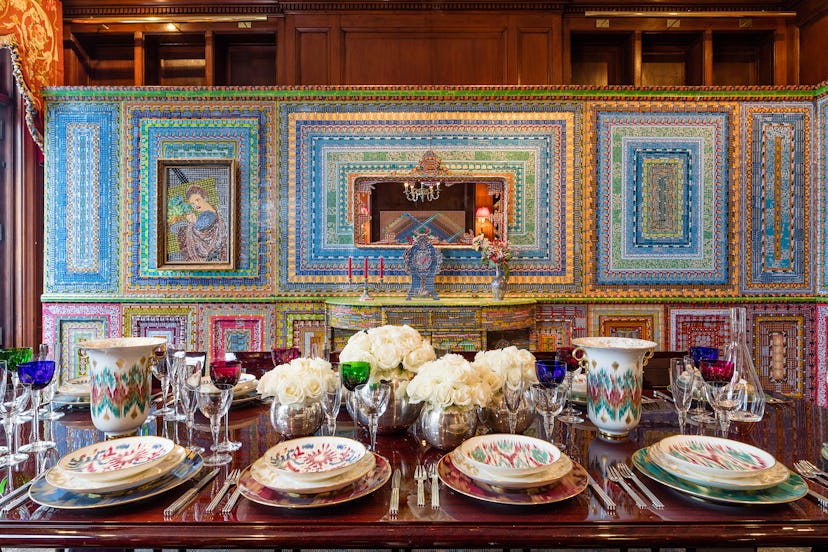What Happens When Artists Take Over an Upper East Side Mansion
For the installation “Be My Guest,” artists like Mickalene Thomas went wild with color to transform a house the likes of which the staid neighborhood had never seen.

On a block steps away from Central Park, a prime luxury apartment spanning several beaux arts townhouses on E. 70th St. went unoccupied for several years before meeting its current tenants: Artworks by the likes of Mickalene Thomas, Misha Kahn, and Barbara Bloom. Now the site of an installation called “Be My Guest,” it’s the latest brainchild of Lisa Cohen, founder of Galerie magazine, and No Longer Empty, a nonprofit New York arts group that sets up art installations in unused spaces, usually in underserved areas like the Bronx.
Though it was a world away from their typical locations, an empty private residence on the Upper East Side is hard to refuse, so founders Manon Slome and Michael Steinberg got to work transforming it into an exploration of the meaning of “home.” Careful not to simply reproduce an interior, they chose to fill the space with artists who comment on domesticity, like Thomas, who constructs elaborate, ornately patterned sets where she photographs her mother, who’s also her muse. A number of those are mounted on the sumptuous, red walls of the living room, where a loaned leopard-print loveseat and a sofa painted by Ena Swansea are meant to match reality with aspiration.
An Upper East Side Mansion Unlike Any You’ve Ever Seen
The living room, featuring photo prints and collages by Mickalene Thomas and a sofa painted by Ena Swansea.
The living room, featuring photo prints and collages by Mickalene Thomas.
The living room, featuring photo prints and collages by Mickalene Thomas.
The living room, featuring photo prints and collages by Mickalene Thomas and a sofa painted by Ena Swansea.
The hall, featuring a mirror by Misha Kahn.
“Ghost of a Dream,” featuring $70,000 worth of discarded lottery cards and Hermès dishware, by artist duo Adam Eckstrom and Lauren Was.
“Ghost of a Dream,” featuring $70,000 worth of discarded lottery cards and Hermès dishware, by artist duo Adam Eckstrom and Lauren Was.
“Ghost of a Dream,” featuring $70,000 worth of discarded lottery cards and Hermès dishware, by artist duo Adam Eckstrom and Lauren Was.
“Ghost of a Dream,” featuring $70,000 worth of discarded lottery cards and Hermès dishware, by artist duo Adam Eckstrom and Lauren Was.
“Ghost of a Dream,” featuring $70,000 worth of discarded lottery cards and Hermès dishware, by artist duo Adam Eckstrom and Lauren Was.
“Ghost of a Dream,” featuring $70,000 worth of discarded lottery cards and Hermès dishware, by artist duo Adam Eckstrom and Lauren Was.
A closet with “Rapture,” a structure of over 300 necklaces, by Jean Shin.
Jean Chin’s “Grafted Settings (Tree)” is made of used cutlery and situated near the dining room.
The master bedroom, “El Nido,” by Teresa Diehl.
The master bedroom, “El Nido,” by Teresa Diehl.
The master bedroom, “El Nido,” by Teresa Diehl.
The dining room, on the other hand, holds an installation called “Dream Home,” where the artist duo Ghost of a Dream (Adam Eckstrom and Lauren Was) spent two weeks arranging $70,000 worth of discarded lottery tickets into an enormous paneled wall unit, plus plates, portraits, a chandelier, and even a working clock. “The dream is the wealth a lottery card can bring you,” Steinberg explained. He added that in case the tickets didn’t pay out, there were additional treasures thanks to brands like Hermès, Puiforcat, and Saint-Louis, who loaned dishware for the cardboard-filled table. (The “piano” room, too, plays with expectations: Instead of an actual piano, there’s a rug by Bloom tracing the outline of an old Steinway.)
Go past a hallway with a cartoonish mirror that faces a fake mirror (by Kahn), and then a tree branched with found cutlery (by Jean Shin), and you’ll arrive at the master bedroom, an otherworldly installation by Teresa Diehl. True to its name—El Nido, “the nest” in Spanish—it’s a dream landscape come to life, featuring audio recordings and video of the birds in Diehl’s garden back in her native Florida. A heartbeat thumps overhead; feathers are glued to the floor; and shiny scrims of fishing line dipped in resin stretch up to the ceiling. There’s a bean bag, too, which visitors are encouraged to lie on.
As of April 18, entry is free, though only by appointment; the rest of the building is decidedly not abandoned.